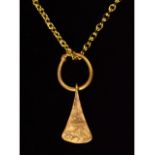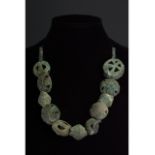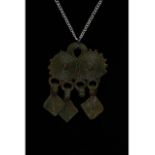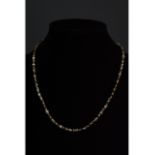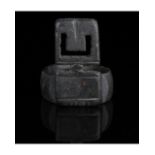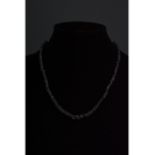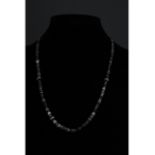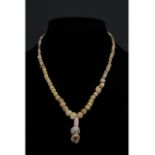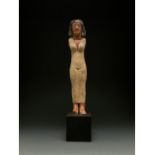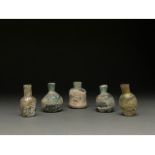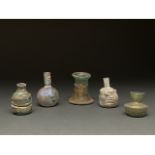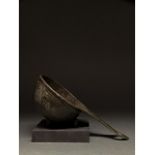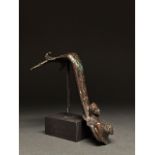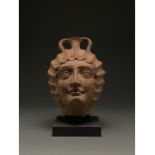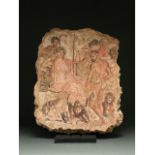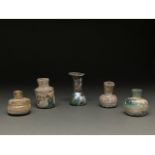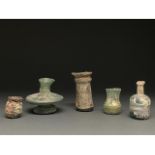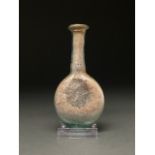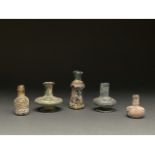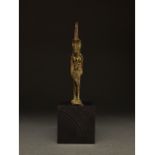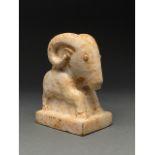Filtered by:
- Show only bulk lots,
- Category
- List
- Grid
A subscription to the Price Guide is required to view results for auctions ten days or older. Click here for more information
700-1100 AD, Viking Age. A superb gold example of an axe or Perun amulet comprising a suspension loop and stylised blade incised cross hatch decor...
Ca.800 - 600 BC. An early necklace formed of bronze pendants in a variety of shapes including bells and spheres (restrung). Bells had magical impl...
Ca.800 BC, Bronze Age. A beautiful Celtic bronze pendant formed as an omega-shaped plaque of round-section wire with coiled ends. The outermost ed...
ROMAN AGATE BEADED NECKLACE
Ca. 1-300 AD. Roman. A restrung necklace of Roman and modern beads comprising beautiful semiprecious blue Roman agate beads interspaced with moder...
ROMAN BRONZE KEY RING
Ca 1-300 AD, Roman. A bronze ring with a thick circular hoop, flattened, rectangular bezel and perpendicular projecting key featuring an openwork ...
ROMAN DARK GLASS BEADED NECKLACE
Ca. 1-300 AD. Roman. A restrung necklace of Roman beads comprising multiple opaqu dark coloured sub-spherical, geometric and disk-shaped and glass...
ROMAN AGATE BEADED NECKLACE
Ca. 1-300 AD. Roman. A restrung necklace of Roman beads comprising beautiful semiprecious blue, grey and black Roman agate beads. The agate beads ...
ROMAN/PARTHIAN BEADED NECKLACE
Ca. 1-300 AD. Roman/Parthian. A restrung necklace of Roman beads comprising beautiful stone, glass and glasspaste beads in creamy yellow hues in a...
664 – 343 B.C. Late Dynastic / Ptolemaic EgyptianEgyptian. Wooden votive figurine of a woman with a bi-partite naturalistic black wig, arching eye...
1-400 AD. Roman and Late Roman. A lot of five blown glass vessels, comprising (L-R): a yellow square sided bottle with a cylindrical neck; a turqu...
Ca. 1-400 AD. Roman and Late Roman. A lot of five blown glass vessels, comprising (L-R): A squat jar with a flaring neck and mouth; a spherical bo...
ROMAN BRONZE PATERA
Ca. 1-300 AD Roman. A beautiful bronze patera comprising a deep body, with incised concentric circles decorating the base, a rounded rim, and a pr...
ROMAN BRONZE PATERA HANDLE
Ca. 1-300 AD Roman. A beautiful bronze patera handle with silver inlay; comprising an attachment where the handle originally joined the vessel, an...
C. 193-211. Roman. This beautiful head pot features a woman’s face comprising high arching brows, upturned, almond shaped eyes, a thin, shapely no...
ROMAN FRESCO FRAGMENT
C. 100 AD or later. Roman style. Fresco fragment depicting an elaborate mythological scene. In the center field, a female figure, probably Ceres, ...
LOT OF ROMAN GLASS JARS
1-400 AD. Roman and Late Roman. A lot of five blown glass vessels, comprising (L-R): A squat cylindrical bottle with a cylindrical neck; a cylindr...
LOT OF ROMAN GLASS JARS
1-400 AD. Roman and Late Roman. A lot of five blown glass vessels, comprising (L-R): a squashed cylindrical miniature jar with inward flaring neck...
ANCIENT GLASS LENTOID FLASK
1-500 AD. Roman and Late Roman. A beautiful lentoid glass bottle with a circular, flattened body, long, straight neck and in-turned rim. The colou...
LOT OF ROMAN GLASS JARS
1-400 AD. Roman and Late Roman. A lot of five blown glass vessels, comprising (L-R): a cylindrical bottle with a sloping shoulder and slightly bul...
Bronze statuette of Nefertum, the Egyptian god of health and perfume, who is one of the few Egyptian gods to be depicted with a human face. He is ...
Western Asiatic. Beautiful cream stone figurine of a prancing ram, with large, curving horns and stylised facial features. The precise significanc...

